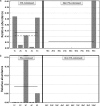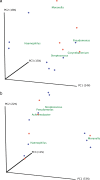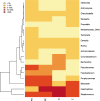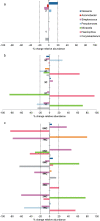Bronchial microbiome of severe COPD patients colonised by Pseudomonas aeruginosa
- PMID: 24449346
- PMCID: PMC4042013
- DOI: 10.1007/s10096-013-2044-0
Bronchial microbiome of severe COPD patients colonised by Pseudomonas aeruginosa
Abstract
The bronchial microbiome in severe COPD during stability and exacerbation in patients chronically colonised by Pseudomonas aeruginosa (PA), has not been defined. Our objective was to determine the characteristics of the bronchial microbiome of severe COPD patients colonised and not colonised by P. aeruginosa and its changes during exacerbation. COPD patients with severe disease and frequent exacerbations were categorised according to chronic colonisation by P. aeruginosa. Sputum samples were obtained in stability and exacerbation, cultured, and analysed by 16S rRNA gene amplification and pyrosequencing. Sixteen patients were included, 5 of them showing chronic colonisation by P. aeruginosa. Pseudomonas genus had significantly higher relative abundance in stable colonised patients (p = 0.019), but no significant differences in biodiversity parameters were found between the two groups (Shannon, 3 (2-4) vs 3 (2-3), p = 0.699; Chao1, 124 (77-159) vs 140 (115-163), p = 0.364). In PA-colonised patients bronchial microbiome changed to a microbiome similar to non-PA-colonised patients during exacerbations. An increase in the relative abundance over 20 % during exacerbation was found for Streptococcus, Pseudomonas, Moraxella, Haemophilus, Neisseria, Achromobacter and Corynebacterium genera, which include recognised potentially pathogenic microorganisms, in 13 patients colonised and not colonised by P. aeruginosa with paired samples. These increases were not identified by culture in 5 out of 13 participants (38.5 %). Stable COPD patients with severe disease and PA-colonised showed a similar biodiversity to non-PA-colonised patients, with a higher relative abundance of Pseudomonas genus in bronchial secretions. Exacerbation in severe COPD patients showed the same microbial pattern, independently of previous colonisation by P. aeruginosa.
Figures





Similar articles
-
Bronchial microbiome, PA biofilm-forming capacity and exacerbation in severe COPD patients colonized by P. aeruginosa.Future Microbiol. 2017 Apr;12:379-392. doi: 10.2217/fmb-2016-0127. Epub 2017 Mar 24. Future Microbiol. 2017. PMID: 28339291
-
Microbiome diversity in the bronchial tracts of patients with chronic obstructive pulmonary disease.J Clin Microbiol. 2012 Nov;50(11):3562-8. doi: 10.1128/JCM.00767-12. Epub 2012 Aug 22. J Clin Microbiol. 2012. PMID: 22915614 Free PMC article.
-
Severity-related changes of bronchial microbiome in chronic obstructive pulmonary disease.J Clin Microbiol. 2014 Dec;52(12):4217-23. doi: 10.1128/JCM.01967-14. Epub 2014 Sep 24. J Clin Microbiol. 2014. PMID: 25253795 Free PMC article.
-
Sputum microbiome profiling in COPD: beyond singular pathogen detection.Thorax. 2020 Apr;75(4):338-344. doi: 10.1136/thoraxjnl-2019-214168. Epub 2020 Jan 29. Thorax. 2020. PMID: 31996401 Free PMC article. Review.
-
A Systematic Review and Meta-Analysis of the Prevalence and Impact of Pulmonary Bacterial Colonisation in Stable State Chronic Obstructive Pulmonary Disease (COPD).Biomedicines. 2021 Dec 31;10(1):81. doi: 10.3390/biomedicines10010081. Biomedicines. 2021. PMID: 35052762 Free PMC article. Review.
Cited by
-
Pseudomonas aeruginosa stimulates nuclear sphingosine-1-phosphate generation and epigenetic regulation of lung inflammatory injury.Thorax. 2019 Jun;74(6):579-591. doi: 10.1136/thoraxjnl-2018-212378. Epub 2019 Feb 5. Thorax. 2019. PMID: 30723184 Free PMC article.
-
Microbiome in chronic obstructive pulmonary disease.Ann Transl Med. 2017 Jun;5(12):251. doi: 10.21037/atm.2017.04.20. Ann Transl Med. 2017. PMID: 28706919 Free PMC article. Review.
-
Genetic mannose binding lectin deficiency is associated with airway microbiota diversity and reduced exacerbation frequency in COPD.Thorax. 2018 Jun;73(6):510-518. doi: 10.1136/thoraxjnl-2016-209931. Epub 2017 Nov 3. Thorax. 2018. PMID: 29101284 Free PMC article.
-
Revisiting the cancer microbiome using PRISM.bioRxiv [Preprint]. 2025 Jan 24:2025.01.21.634087. doi: 10.1101/2025.01.21.634087. bioRxiv. 2025. PMID: 39896561 Free PMC article. Preprint.
-
Characterization of the lung microbiome and exploration of potential bacterial biomarkers for lung cancer.Transl Lung Cancer Res. 2020 Jun;9(3):693-704. doi: 10.21037/tlcr-19-590. Transl Lung Cancer Res. 2020. PMID: 32676331 Free PMC article.
References
-
- Soler N, Torres A, Ewig S, Gonzalez J, Celis R, El-Ebiary M, Hernandez C, Rodriguez-Roisin R. Bronchial microbial patterns in severe exacerbations of chronic obstructive pulmonary disease (COPD) requiring mechanical ventilation. Am J Respir Crit Care Med. 1998;157(5 Pt 1):1498–1505. doi: 10.1164/ajrccm.157.5.9711044. - DOI - PubMed
Publication types
MeSH terms
Substances
Associated data
LinkOut - more resources
Full Text Sources
Other Literature Sources
Medical

